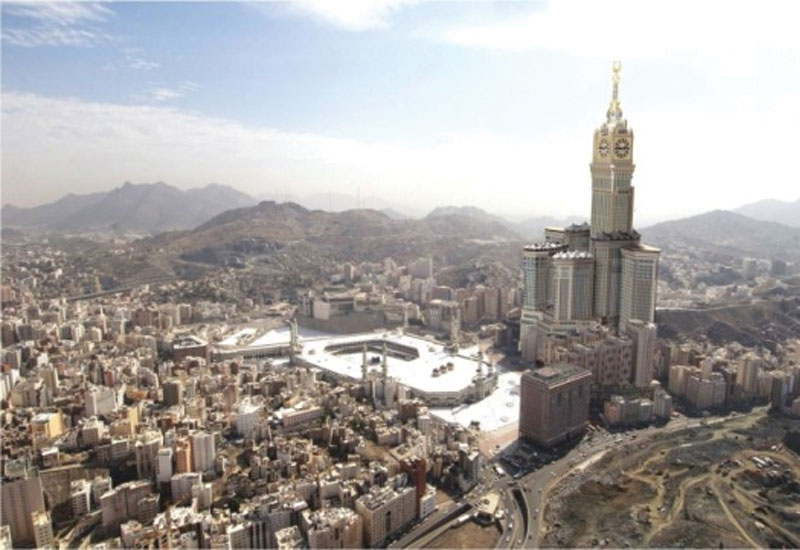 Located adjacent to the Masjid al Haram, Makkah Clock Royal Tower, A Fairmont Hotel stands 76-storeys tall and features a 40-metre Royal Clock, visibl
Located adjacent to the Masjid al Haram, Makkah Clock Royal Tower, A Fairmont Hotel stands 76-storeys tall and features a 40-metre Royal Clock, visibl
Quality Product
The healthy economy and the addition of new hotels to the Saudi Arabian market is also encouraging existing hotels to improve the quality of their product, with Four Seasons Hotel Riyadh recently undergoing a renovation to bring the property up to the standard which visitors to Saudi Arabia, and internal travellers, now expect from hotels in the Kingdom.
Four Seasons Riyadh general manager Rami Sayess reveals: “The renovation discussions started almost three years ago and what triggered that are a few things. First of all, although the hotel is only seven years old, things are moving very fast in terms of technology, in terms of new designs and guest expectations — so we saw an opportunity that, especially with the economic crisis hitting in 2008-2009, we thought it was better to use that soft few years to try and complete that renovation during that time and also what really helped us is the support we have received from the ownership of the group who strongly believe in the product and in its potential to grow further.”

| Advertisement |
This focus on quality is in line with the vision of the Saudi Commission for Tourism and Antiquities (SCTA), as its vice president investment Dr Salah Al Bukkayet, explains: “Right now our focus is domestic tourism and religious tourism. And the reason we are focusing on domestic tourism is because of the fact that we are exporting a lot of tourists with a lot of money.
“The reason that Saudi Arabian tourists are travelling abroad is because the tourism offering in the country is just not acceptable to them both from a quality and a price point of view. So for us it’s not logical to invite somebody to come when the tourism offering is not satisfactory to your own. They have to travel abroad to get this kind of experience so our focus right now over the next three to five years is product development, product development and product development,” continues Al Bukkayet.
“We need to develop our tourism facilities from a quantity and a quality point of view to the level that we think is satisfactory to our own tourists, because international tourists are by definition very experienced and they know what to expect when they come to another area.
“So we would like to focus right now on improving our tourism offering as a country, and once we have reached that level of conviction that we are now ready to attract international tourists, then we will have no problems. We have an expat community of more than six million living within the country and they travel within Saudi Arabia and we have no issues with them,” asserts Al Bukkayet.
Tourist Arrivals
Increased flight routes to the Kingdom will assist in this ultimate focus on foreign visitors. Emirates Airline is currently increasing its presence in the Kingdom — raising its weekly number of flights to Riyadh and Jeddah to 12, and operations between the UAE and KSA by 71%, also increasing the economic ties between the two countries.
“The introduction of an additional 3770 seats per week on the two routes will further enhance the passenger movement between the two countries. Business and leisure travellers in Saudi Arabia are seeking connectivity to key commercial and leisure centres in Europe, as well as to the Americas and Australasia — and these new flights will help expedite their journey. Religious based travel to Saudi Arabia also continues to grow exponentially each year, with these additional flights set to add some much needed capacity for inbound traffic,” says Ahmed Khoory, Emirates senior vice president commercial operations, Gulf, Middle East and Iran.
Emirates remains committed to the Saudi market with a total of 38 flights per week to four cites including; Riyadh, Jeddah, Dammam and Al Medina al Munawarah.
Although there has been an increase in flights across the country, and visitor numbers are predicted to rise, challenges still remain in the Saudi Arabian market; visa regulations have long been notoriously stringent — something the aspiring hotelier branching in to KSA must consider in terms of acquiring visas for staff members — and regulations laid out by the government will see a five year plan requiring hotels to reach Saudisation figures of 80% by 2015.
However, the situation is not entirely bleak, with several hoteliers reporting relaxation of visa regulations, and others reporting successful Saudisation figures of 32% (the current requirement) and above.
“Visas are not necessarily a deterrent for people to come,” argues Rosewood’s Leitzke.
“It’s just a process and it can be tedious and complicated at times but I think that the process has improved, Saudi Arabia starts to open up a little bit. You hear now that there are some group visas being made available, tourism starts to increase and again we can look at the religious travel alone and this is also on the upward trend and a lot of things are being done in Makkah itself — new hotels are being built, faculties are modernised, upgraded and so forth,” he adds.
It seems that hoteliers are right to be looking at securing new flags in the Kingdom — with ease of travel improving, visitor numbers predicted to almost double over the next four years, and the internal markets of Makkah and Madinah guaranteed to attract visitors regardless of the state of the global economy; this market is one which will continue make a huge impact on the Middle East’s tourism industry.
As HMH’s Noblet concludes; “Saudi Arabia is the biggest market in the Gulf — simple as that.”








 Search our database of more than 2,700 industry companies
Search our database of more than 2,700 industry companies









